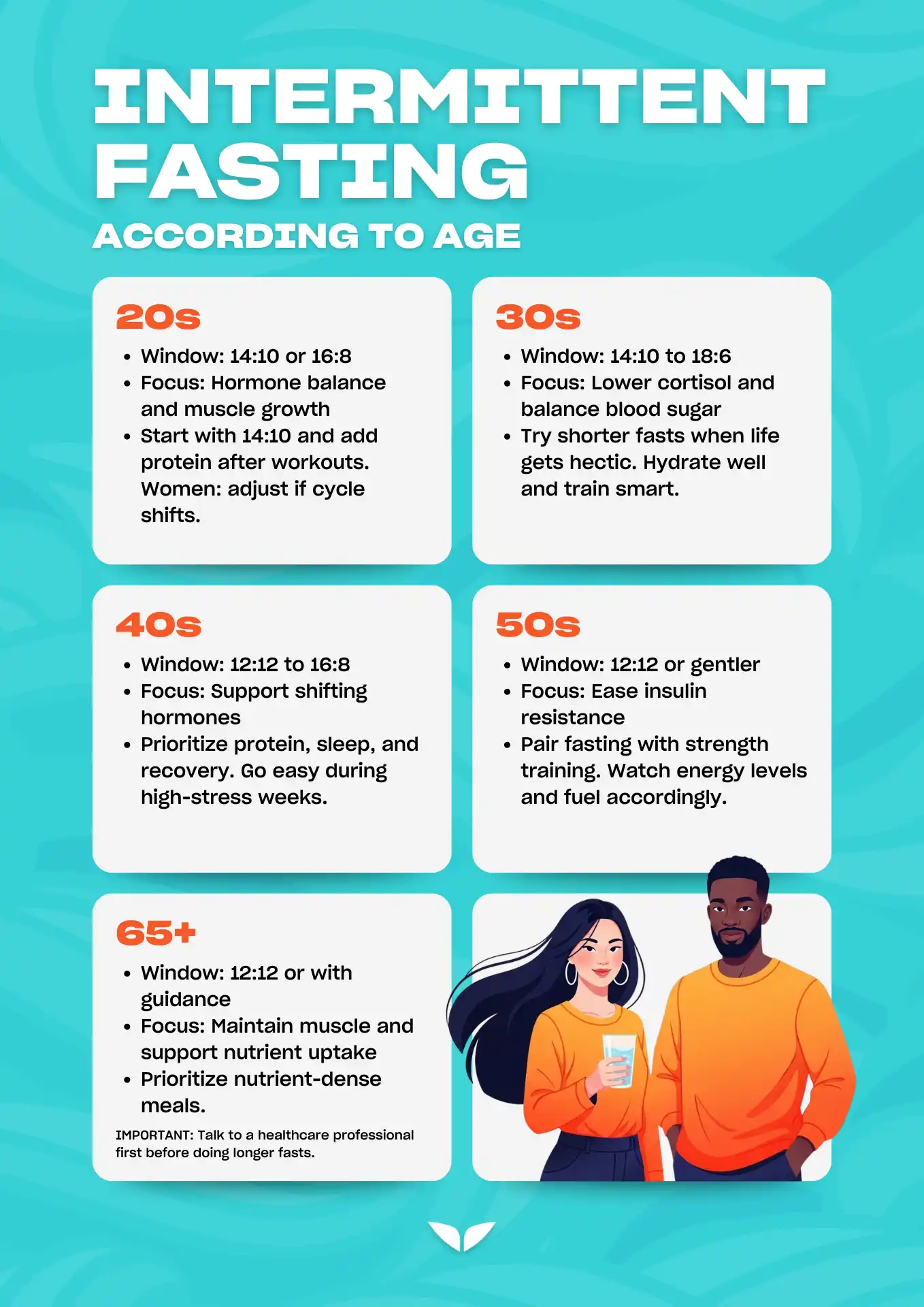At 25, you skip breakfast, crush a spin class, and somehow survive on iced coffee and hope. At 45, the same routine leaves you foggy, ravenous, and wondering if your metabolism died in its sleep.
The reality is, your body has moved on from the fast-all-day, glow-all-night nonsense that once sort of worked. Metabolism slows, hormones riot, muscle becomes stubborn, and fasting, when done like you’re still in your twenties, starts to backfire.
That’s why turning to the intermittent fasting by age chart offers a strategy your future self might actually thank you for.
What is intermittent fasting?
Intermittent fasting (IF, for short) is a time-based eating schedule where you cycle between periods of fasting and eating. It’s as simple as that. No rules about what to eat. Just when.
You’ll see several types of fasting, the most common being 16:8 (16 hours of fasting, 8 hours of eating). But it can be 14:10, 12:12, or even alternate days depending on your goals. The idea is to give your body regular, predictable breaks from digestion so it can focus on repair, hormone balance, and not hoarding fat like winter’s coming.
Think of it less like a diet and more like a “lifestyle,” as Ronan Diego, a holistic health mentor, puts it in his Beyond Fasting program on Mindvalley. One that works with your biology, improves insulin response, and activates cellular repair processes (a.k.a., autophagy, if you want to sound scientific at dinner parties).
People have done this for centuries—spiritually (like Muslims during Ramadan), culturally (like Indigenous communities before hunts, ceremonies, or rites of passage), and accidentally (when they forgot to grocery shop).
“If you are not eating right at this moment, that means you’re fasting,” Ronan adds. But the key, he points out, is the length of the fast. After a certain point, your body shifts gears and starts running on a different kind of metabolism.
And just to clear the air: IF isn’t about restriction or punishment. If you’re skipping meals out of guilt or fear, that’s not fasting.
How does intermittent fasting work?
When you stop eating for long enough, your body flips from “storage mode” to “repair mode.” Insulin drops, fat stores unlock, and your cells start spring cleaning.
Think of your metabolism as a switch. When you’re constantly snacking, you’re always burning the quick stuff like glucose.
But, as Ronan explains, when you fast long enough, you “empty the storage inside of your muscles and your liver and start pulling the energy from the fat cells.” And then, your body starts doing what it rarely gets to do: repair itself.
So what else goes on under the hood? Here’s a breakdown, based on research on the metabolic effects of intermittent fasting:
- Insulin levels drop. What insulin does is tell your body to store fat. So when you fast, it drops, giving your cells permission to burn what’s already there.
- Fat becomes fuel. Without carbs coming in, your body turns to fat. It breaks it down into ketones, which become your new energy source. This is metabolic switching, which is your backup system kicking in.
- Autophagy kicks in. It’s essentially cellular cleanup. Old, damaged cells get recycled.
- Hormones rebalance. Fasting boosts human growth hormone (HGH), improves insulin sensitivity, and may influence hunger hormones like ghrelin and leptin.
- Circadian rhythms realign. Eating within daylight hours helps sync your body clock, which can improve your sleep schedule, digestion, and metabolism.
Of course, how well all this works depends on when you fast, how long, and what stage of life your body’s currently navigating. Because your metabolism at 25 doesn’t play by the same rules at 45…or 65.
Disclaimer: This information is for educational purposes only and is not intended as medical advice. Always consult a healthcare professional before starting any fasting protocol, especially if you have underlying conditions or take medications.
Intermittent fasting by age chart
Not all bodies age the same way. Hormones get louder, sleep gets weirder, stress sticks around like glitter, and your metabolism starts taking longer coffee breaks.
Men and women, too, need different strategies when it comes to time-restricted eating. Most versions of the intermittent fasting by age chart for males suggest that men can usually stick to a schedule without much hormonal drama. But intermittent fasting for women often works better when the timing adjusts to their hormonal cycles, not the other way around.
Lena Bakovic, MS, RDN, CNSC, a registered dietitian nutritionist, tells Pulse that hormone swings during menstruation, pregnancy, and menopause can mess with appetite, energy, and insulin. She further explains that it can “make fasting more challenging,” which is why tailoring your approach to your hormonal landscape is essential
So what’s your eating window for this stage of your life right now? You can refer to this intermittent fasting by age chart:
| Age group | Recommended fasting window | Physiological focus | Tip for males | Tip for females |
| 20s | 14:10 or 16:8 | Hormone stability, muscle growth | Build lean mass and support testosterone with consistent eating post-fasting. | Avoid prolonged fasts if cycle irregularities occur; sync fasting with low-hormone phases. |
| 30s | 14:10 to 18:6 | Cortisol load, blood sugar balance | Do time fasts after strength training; stay hydrated to protect muscle. | Consider shorter fasts during high-stress periods or luteal phase. |
| 40s | 12:12 to 16:8 | Perimenopause or testosterone shifts | Support hormone levels with protein-rich meals during eating windows. | Prioritize protein and sleep; fasting can amplify stress in this decade. |
| 50s | 12:12 or gentler | Menopause, metabolic shift | Maintain muscle with resistance training post-fast. | Use fasting to ease insulin resistance, but monitor energy dips closely. |
| 65+ | 12:12 or medical supervision | Nutrient absorption, frailty risk | Stick to shorter windows and ensure adequate calories. | Focus on nutrient density, and seek professional guidance before extended fasting. |

Physiology of aging & fasting
Two people can follow the same intermittent fasting schedule and feel completely different. The reason? Biology.
You could get technical and look at an intermittent fasting chart by age and weight, but what really makes a difference is knowing what your body’s working with (and working against) at every stage of life.
| In your 20s, growth hormone is high, metabolism is fast, and your body rebounds from everything, like revenge bedtime procrastination, skipped meals, and one too many Jägerbombs. Fasting feels easy here, especially if your goal is maintenance or fat loss. But most 20-somethings underconsume protein and overdo caffeine, which makes longer fasts harder to sustain well. |
| In your 30s, cortisol creeps up, stress hits differently, blood sugar isn’t as stable as it used to be, and sleep starts to matter more. Fasting can help regulate all of it…if you’re not already burning out from overtraining, undereating, and answering Slack messages at midnight. |
| In your 40s, hormones start throwing curveballs. Estrogen and progesterone begin their slow exit, testosterone drops, and the thyroid might start dragging. Therefore, recovery takes longer. That’s why most versions of the intermittent fasting by age chart for women recommend a gentler rhythm, paired with bodyweight exercises, more protein, and more sleep than you’re probably getting. |
| In your 50s and beyond, muscle loss (sarcopenia) speeds up, bone density may decline, and appetite might shrink even when your body needs more nutrients. This is not the time for aggressive fasting. Instead, focus on shorter eating windows, stay hydrated, and make protein your non-negotiable. Lena also recommends pairing adequate protein with resistance training to support muscle repair and sticking to balanced, whole-food meals to keep your metabolism steady without slipping into underfueling. |
Fasting do’s & don’ts by life stage
Your fasting window isn’t the only thing that needs adjusting as you age. What you eat, how you move, and how you recover matter just as much.
Don’t make the fasting complicated. Fasting is supposed to make your life easier and not harder.
— Ronan Diego, trainer of Mindvalley’s Beyond Fasting program
So, before you commit to skipping breakfast forever, read this first.
| Age group | Do’s | Don’ts |
| 20s | Start with 14:10 or 16:8 to build consistency Eat enough protein to support muscle growth Use fasting to support gut health and energy, not crash dieting | Overdo caffeine and call it “biohacking” Skip meals to save calories for drinking alcohol Fast through intense workouts without proper refueling |
| 30s | Use fasting to balance blood sugar and stress Opt for quality sleep over squeezing in fasted workouts Cycle your fasting windows based on stress levels | Push 18:6 or OMAD when your adrenals are already fried Ignore signs of burnout like fatigue or feeling overwhelmed Treat every weekday like a willpower test |
| 40s | Pair fasting with resistance training and more protein Listen to your thyroid and mood before tightening your window Use fasting to create routine, not restriction | Assume what worked at 25 will still work now Fast through perimenopause symptoms without support Chase weight loss at the cost of sleep and sanity |
| 50s and beyond | Keep windows shorter (12:12 to 14:10 works well) Focus on nutrient density and daily hydration Talk to a practitioner if you’re on meds or managing chronic conditions | Let fasting replace meals; undereating is not the goal Skip strength training (muscle is medicine now) Expect aggressive fasting to feel good or even safe |
As you age, you’re at greater risk of missing key nutrients, especially while fasting. Lena’s advice is to make every eating window count.
“Nutrient requirements alter with aging, and there is a likelihood for nutrient deficiencies of vitamin B12, calcium, vitamin D, and iron,” she says.
So load your plate with lean protein, vegetables, whole grains, healthy fats, and plant-based options. And getting labs done and supplementing when needed can help fill the gaps food can’t.
Bonus: your personalized intermittent fasting checklist
You’ve seen the intermittent fasting by age chart. Now here’s how to actually use it to build a routine that fits your life, your body, and your goals.
- Pick your next milestone. What do you actually care about achieving in the next month? Weight loss? Stronger immunity? Sharper focus? Choose one goal that lights a fire under you and write it down.
- Choose your fasting protocol based on how ready you feel. Ronan offers four levels to choose from: testing the waters (12–16 hours, flexible and forgiving), chill (14–16 hours with a few off-days allowed), like a boss (16 hours daily with minimal slip-ups), and master (16 hours daily at the same time, no exceptions).
- Define your fasting rules. What’s allowed in your fasting window? Black coffee? Bone broth? Electrolytes? Your decision depends on your goal. Commit to your own list and stick to it.
- Plan your eating window and keep it consistent. If you always eat between 10 AM and 6 PM, your circadian rhythm will thank you. Your hormones, digestion, and sleep quality will get a boost, too.
- Rewire how you eat. No more eating while standing, driving, or scrolling. Sit at a table, use a plate and cutlery, and ditch the distractions. This simple shift helps your brain register real meals and reduces the urge to overeat later.
- Supplement wisely. Nutritional biochemist Shawn Wells, MPH, LDN, RD, CISSN, FISSN, recommends in his Mindvalley program, The Ultimate Guide to Supplements, using electrolytes to stay hydrated, ketones to fuel fat burning, and targeted compounds like NAC, CurcuPrime, and dihydroberberine to support detoxification and metabolic health.
- Adjust as needed. If 16 hours feels like a push, do 14. “Don’t make the fasting complicated,” says Ronan. “Fasting is supposed to make your life easier and not harder.”
Frequently asked questions
Is intermittent fasting healthy?
Yes, when done right. Intermittent fasting…
- trains your metabolism,
- improves insulin sensitivity,
- reduces inflammation,
- maintains hormonal balance, and
- supports weight loss.
Now, the thing is, your body isn’t designed to graze 24/7. So, giving it time between meals activates cellular repair (hello, autophagy), balances blood sugar, and helps your digestive system take a breather.
But it’s not for everyone. If you’re pregnant, underweight, under 18, or have a history of eating disorders, skip it or talk to your doctor first.
Can you drink coffee while intermittent fasting?
Yes, black coffee is fair game. In fact, it might even make it easier by curbing hunger and giving your brain a little boost. One small study even found that black coffee had no significant effect on blood glucose or triglycerides during metabolic testing.
It has almost no calories and won’t break your fast. Just skip the cream, sugar, and syrups. Once you start adding those, forget fasting. It’s more of a dessert in a mug.
Some people also add electrolytes or even a splash of MCT oil during longer fasts, but that depends on your goals. If you’re fasting for metabolic benefits or fat burn, it’s fine. If you’re chasing deep autophagy, play it cleaner.
Drink smart. Your coffee shouldn’t count as breakfast.
How does intermittent fasting impact metabolism?
Intermittent fasting gives your metabolism a reset button. When you go long enough without eating, insulin drops, your body starts burning it, and autophagy happens.
Your body also begins to make better use of energy. Instead of burning quick sugars all day, it taps into fat stores and boosts ketone production. That means your energy is more stable, you’ve got better focus, and you’re less hangry.
According to an umbrella review of 153 studies, all major forms of intermittent fasting, like time-restricted eating and alternate-day fasting, were more effective at improving metabolic health than standard diets or continuous calorie restriction.
And yes, it can support weight loss, too. But the real win is metabolic flexibility: your body’s ability to switch fuel sources, balance hormones, and avoid the blood sugar rollercoaster.

Futureproof your well-being
Most of us try intermittent fasting and blame ourselves when it backfires. We get mood swings, stubborn weight, burnout, and hormone chaos… without realizing there’s an intermittent fasting by age chart we can turn to.
…Or a free Mindvalley masterclass that teaches you how to fast smarter, not harder. Guided by Ronan Diego and Vishen, Mindvalley’s CEO, you’ll learn how to:
- Burn fat without burning out,
- Balance hormones without guesswork,
- Find your personal fasting sweet spot, and
- Boost clarity, energy, and longevity.
More than 66,000 students have used this system to reset their metabolism and reclaim their health. Like Alexis Rotenberg, a VP from the U.K., who says he finally found a way to fast without stress—one that fit his jet-setting schedule, demanding job, and social life. He shares on Mindvalley Stories:
Learning to eat well without compromising its pleasures is one of the greatest gifts of life and this Quest gives people this incredible opportunity.
At the end of the day, fasting is about precision, not restriction. And Mindvalley shows you how.
Welcome in.










